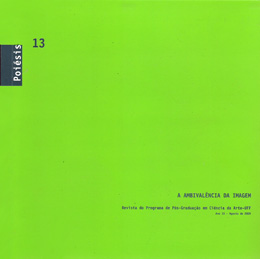O perfil de movimento de Kestenberg: categorias de análise e aplicação preliminar em dança
DOI:
https://doi.org/10.22409/poiesis.1013.135-144Keywords:
análise de movimento, ritmo, coreografiaAbstract
Este artigo apresenta o método prioritariamente terapêutico denominado Kestenberg Movement Profile (KMP), desenvolvido por Dra. Judith Kestenberg - psiquiatra e discípula de Rudolf Laban -, para aplicação preliminar na análise rítmica comparativa de duas obras coreográficas, estabelecendo uma relação inédita entre KMP e dança.Downloads
References
Allison, Nancy, org. (1999). The Illustrated Enciclopedia of Body-Mind Disciplines. New York: The Rosen
Publishing Group.
Amighi, J. K.; Loman, S.; Lewis, P.; e Sossin, K. M. (1999). The Meaning of Movement, Developmental and
Clinical Perspectives of the Kestenberg Movement Profile. New York: Routledge Publishers.
Barba, Eugenio e Savarese, Nicola (1995). A Arte Secreta do Ator. Dicionário de Antropologia Teatral. São Paulo:
HUCITEC.
Bartenieff, Irmgard (1980). Body movement: Coping with the environment. Langhorne: Gordon and Breach.
Cohen, Bonnie Bainbridge (1993). Sensing, Feeling, and Action. The Experiential Anatomy of Body-Mind
Centering. Northampton: Contact Editions.
Cohen, Renato (1998). Work in Progress na Cena Contemporânea. Criação, Encenação, Recepção. São Paulo:
Perspectiva.
Fernandes, Ciane (2006). O Corpo em Movimento: O Sistema Laban/Bartenieff na Formação e Pesquisa em
Artes Cênicas. São Paulo: Annablume. 2ª Edição.
Hackney, Peggy (1998). Making Connections. Total Body Integration Through Bartenieff Fundamentals.
Amsterdam: Gordon and Breach Publishers.
Kestenberg, Judith S. (1975). Children and Parents. New York: Jason Aronson.
__________ (1965a): The role of movement patterns in development: 1. Rhythms of movement. Psychoanalytic
Quarterly, n.34: 1-36.
__________ (1965b). The role of movement patterns in development: 2. Flow of tension and effort. Psychoanalytic
Quarterly, n.34: 517-563.
__________ (1977). The Role of Movement Patterns in Development. Vol. I. New York: Dance Notation Bureau.
Kestenberg, Judith S.; Sossin, K. Mark (1979). The Role of Movement Patterns in Development. Vol.II. New
York: Dance Notation Bureau.
Laban. Rudolf (1920). Die Welt des Tänzers. Stuttgart: W. Seifert.
__________ (1976). The Language of Movement. A Guidebook to Choreutics. Lisa Ullmann, ed. Boston: Plays Inc.
LABAN, Rudolf e LAWRENCE, F. C. (1974). Effort. Economy of Human Movement. Estover, Plymouth:
Macdonald & Evans.
LAMB, Warren (1963). Posture and Gesture: An Introduction to the Study of Physical Behaviour. Londres:
Gerald Duckworth.
Lepecki, André (2005). Desfazendo a fantasia do sujeito (dançante): ‘Still acts’ em The Last Performance de
Jérôme Bel. In Lições de Dança n.5: 11-26.
Maletic, Vera (1987). Body - Space - Expression. The Development of Rudolf Laban’s Movement and Dance
Concepts. Berlin: Mounton de Gruyter.
Pallaro, Patricia, org. (1998) Authentic Movement: Essays by Mary Whitehouse, Janet Adler, and Joan
Chodorow. Volume I. Londres: Jessica Kingsley Publishers.
Prince, Robert (2006). Judith Kestenberg. In The Sphinx. A Forum for Inquiry and Innovation in Psychoanalysis.
Section V. Continuing Education. http://www.sectionfive.org/continuing_education/kestenberg/. Division of
Psychoanalysis. Consultado em 29.01.2008.
Downloads
Published
How to Cite
Issue
Section
License
Authors who publish in Revista Poiésis agree to the following terms:
- The authors keep the copyright and grant the journal the right of first publication. The work is automatically licensed under the Creative Commons Attribution License, which enables its sharing as long as the authorship and initial publication in this journal are acknowledged.
- Authors are allowed and encouraged to distribute online their work published in Revista Poiésis (in institutional repositories or in their own personal page), since this can generate productive interactions, as well as increase the impact and citation of the published work (See The Effect of Free Access).


